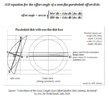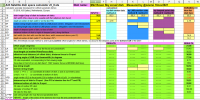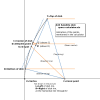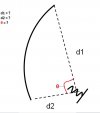a33
Specialised Contributor
- Joined
- Sep 24, 2009
- Messages
- 1,282
- Reaction score
- 743
- Points
- 113
- Age
- 64
- My Satellite Setup
-
XSAT410
Rebox RE-9000
- My Location
- The Netherlands
When you want to check or calculate the focal point position of your offset dish, the well known equation of John Legon (from his article Calculation of the focal length of an offset satellite dish antenna) might be handy.
His formula for the focal length of a paraboloid offset dish is quite simple, but he uses the depth at the deepest point of the dish as one of the input measures ~ which is not the easiest point of the dish to ascertain.
I managed to derive an equation, using the depth measure at the center of the dish, instead of the depth measure at the deepest point.
The resulting equation is a bit longer than John Legon's, but not really difficult.
Finding the depth at the center of the dish, however, and measuring thát, I find relatively easy.
The equation is:
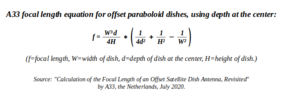
Attached here is also the article, in which I describe the steps of the derivation: "Calculation of the Focal Length of an Offset Satellite Dish Antenna, Revisited". The base of the derivation is a special property of paraboloid dishes, that I discovered not long ago ~ but it might be common knowledge to mathematicians, I don't know.
I wouldn't expect that everyone would be able to follow the math in the derivation, but for all those who are interested, all the steps are there.
The equations described in the article give exactly the same outcomes as the more extensive calculation procedures that I used before in my (offset) satellite dish spreadsheet calculator, so I'm quite satisfied that all the equations are correct.
So I hope you'll enjoy the reading, and the use of the equation!
Greetz,
A33
His formula for the focal length of a paraboloid offset dish is quite simple, but he uses the depth at the deepest point of the dish as one of the input measures ~ which is not the easiest point of the dish to ascertain.
I managed to derive an equation, using the depth measure at the center of the dish, instead of the depth measure at the deepest point.
The resulting equation is a bit longer than John Legon's, but not really difficult.
Finding the depth at the center of the dish, however, and measuring thát, I find relatively easy.
The equation is:

Attached here is also the article, in which I describe the steps of the derivation: "Calculation of the Focal Length of an Offset Satellite Dish Antenna, Revisited". The base of the derivation is a special property of paraboloid dishes, that I discovered not long ago ~ but it might be common knowledge to mathematicians, I don't know.
I wouldn't expect that everyone would be able to follow the math in the derivation, but for all those who are interested, all the steps are there.
The equations described in the article give exactly the same outcomes as the more extensive calculation procedures that I used before in my (offset) satellite dish spreadsheet calculator, so I'm quite satisfied that all the equations are correct.
So I hope you'll enjoy the reading, and the use of the equation!
Greetz,
A33
Attachments
Last edited:

